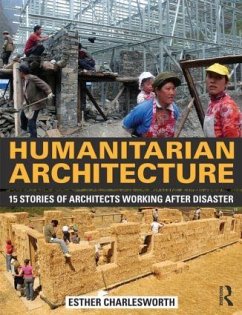- Broschiertes Buch
- Merkliste
- Auf die Merkliste
- Bewerten Bewerten
- Teilen
- Produkt teilen
- Produkterinnerung
- Produkterinnerung
This book documents and analyses the expanding role for architects in designing projects for communities after the event of a natural disaster. The fifteen case studies featured in the body of the book illustrate how architects can use spatial sensibility and integrated problem-solving skills to help alleviate both human and natural disasters.
Andere Kunden interessierten sich auch für
![Daylighting and Integrated Lighting Design Daylighting and Integrated Lighting Design]() Christopher MeekDaylighting and Integrated Lighting Design45,99 €
Christopher MeekDaylighting and Integrated Lighting Design45,99 €![Building Information Modeling Building Information Modeling]() Karen KensekBuilding Information Modeling43,99 €
Karen KensekBuilding Information Modeling43,99 €![Architecture and Capitalism Architecture and Capitalism]() Architecture and Capitalism68,99 €
Architecture and Capitalism68,99 €![Futurestorative Futurestorative]() Martin BrownFuturestorative50,99 €
Martin BrownFuturestorative50,99 €![The Changing Shape of Practice The Changing Shape of Practice]() The Changing Shape of Practice71,99 €
The Changing Shape of Practice71,99 €![Design Education for a Sustainable Future Design Education for a Sustainable Future]() Rob FlemingDesign Education for a Sustainable Future60,99 €
Rob FlemingDesign Education for a Sustainable Future60,99 €![Structure and Architecture Structure and Architecture]() Angus J MacdonaldStructure and Architecture60,99 €
Angus J MacdonaldStructure and Architecture60,99 €-
-
-
This book documents and analyses the expanding role for architects in designing projects for communities after the event of a natural disaster. The fifteen case studies featured in the body of the book illustrate how architects can use spatial sensibility and integrated problem-solving skills to help alleviate both human and natural disasters.
Produktdetails
- Produktdetails
- Verlag: Taylor & Francis
- Seitenzahl: 264
- Erscheinungstermin: 26. Juni 2014
- Englisch
- Abmessung: 246mm x 187mm x 20mm
- Gewicht: 732g
- ISBN-13: 9780415818674
- ISBN-10: 0415818672
- Artikelnr.: 40478121
- Herstellerkennzeichnung
- Libri GmbH
- Europaallee 1
- 36244 Bad Hersfeld
- gpsr@libri.de
- Verlag: Taylor & Francis
- Seitenzahl: 264
- Erscheinungstermin: 26. Juni 2014
- Englisch
- Abmessung: 246mm x 187mm x 20mm
- Gewicht: 732g
- ISBN-13: 9780415818674
- ISBN-10: 0415818672
- Artikelnr.: 40478121
- Herstellerkennzeichnung
- Libri GmbH
- Europaallee 1
- 36244 Bad Hersfeld
- gpsr@libri.de
Esther Charlesworth is the Founding Director of Architects without Frontiers (Australia), a design non-profit organization committed to working with communities in need. She is Associate Professor in Architecture and Design at RMIT University, Melbourne, Australia.
Acknowledgements Foreword: Human Architecture
Michael Sorkin Introduction: A World of Disasters: The Rise and Rise of Humanitarian Architecture
Esther Charlesworth Part 1: Private Architecture Practice Based Humanitarian Architects 1. Voluntary Architect's Network, Japan
Shigeru Ban 2. Atelier 3, Taiwan
Hsieh Ying
Chun 3. Mass Design Group, USA
Michael Murphy 4. Healthabitat, Australia
Paul Pholeros 5. Community Architects for Shelter and Environment (CASE), Thailand
Patama Roonrakwit Part 2: University
Research Based Humanitarian Architects 6. Architecture for Humanity, USA
Nathaniel Corum 7. Gulf Coast Community Design Studio, USA
David Perkes Part 3: NGO/International Aid Based Humanitarian Architects 8. Department of International Development, UK
Lizzie Babister 9. Architecture for Humanity, Japan
Eric Cesal 10. International Federation of the Red Cross and Red Crescent Societies (IFRC), Switzerland
Sandra D'Urzo 11. World Vision International, Australia
Brett Moore 12. International Federation of the Red Cross and Red Crescent Societies, Switzerland
Graham Saunders 13. Ahmedabad Study Action Group (ASAG), India
Kirtee Shah 14. UN
HABITAT, Haiti
Maggie Stephenson 15. Cordaid, The Netherlands
Anna Wachtmeister Part 4: Future Roles for the Humanitarian Architect Epilogue 1: Putting the public in design
Bryan Bell Epilogue 2: Architecture as service
Ian Davis Epilogue 3: Sending out an SOS
Rory Hyde Glossary Index.
Michael Sorkin Introduction: A World of Disasters: The Rise and Rise of Humanitarian Architecture
Esther Charlesworth Part 1: Private Architecture Practice Based Humanitarian Architects 1. Voluntary Architect's Network, Japan
Shigeru Ban 2. Atelier 3, Taiwan
Hsieh Ying
Chun 3. Mass Design Group, USA
Michael Murphy 4. Healthabitat, Australia
Paul Pholeros 5. Community Architects for Shelter and Environment (CASE), Thailand
Patama Roonrakwit Part 2: University
Research Based Humanitarian Architects 6. Architecture for Humanity, USA
Nathaniel Corum 7. Gulf Coast Community Design Studio, USA
David Perkes Part 3: NGO/International Aid Based Humanitarian Architects 8. Department of International Development, UK
Lizzie Babister 9. Architecture for Humanity, Japan
Eric Cesal 10. International Federation of the Red Cross and Red Crescent Societies (IFRC), Switzerland
Sandra D'Urzo 11. World Vision International, Australia
Brett Moore 12. International Federation of the Red Cross and Red Crescent Societies, Switzerland
Graham Saunders 13. Ahmedabad Study Action Group (ASAG), India
Kirtee Shah 14. UN
HABITAT, Haiti
Maggie Stephenson 15. Cordaid, The Netherlands
Anna Wachtmeister Part 4: Future Roles for the Humanitarian Architect Epilogue 1: Putting the public in design
Bryan Bell Epilogue 2: Architecture as service
Ian Davis Epilogue 3: Sending out an SOS
Rory Hyde Glossary Index.
Acknowledgements Foreword: Human Architecture
Michael Sorkin Introduction: A World of Disasters: The Rise and Rise of Humanitarian Architecture
Esther Charlesworth Part 1: Private Architecture Practice Based Humanitarian Architects 1. Voluntary Architect's Network, Japan
Shigeru Ban 2. Atelier 3, Taiwan
Hsieh Ying
Chun 3. Mass Design Group, USA
Michael Murphy 4. Healthabitat, Australia
Paul Pholeros 5. Community Architects for Shelter and Environment (CASE), Thailand
Patama Roonrakwit Part 2: University
Research Based Humanitarian Architects 6. Architecture for Humanity, USA
Nathaniel Corum 7. Gulf Coast Community Design Studio, USA
David Perkes Part 3: NGO/International Aid Based Humanitarian Architects 8. Department of International Development, UK
Lizzie Babister 9. Architecture for Humanity, Japan
Eric Cesal 10. International Federation of the Red Cross and Red Crescent Societies (IFRC), Switzerland
Sandra D'Urzo 11. World Vision International, Australia
Brett Moore 12. International Federation of the Red Cross and Red Crescent Societies, Switzerland
Graham Saunders 13. Ahmedabad Study Action Group (ASAG), India
Kirtee Shah 14. UN
HABITAT, Haiti
Maggie Stephenson 15. Cordaid, The Netherlands
Anna Wachtmeister Part 4: Future Roles for the Humanitarian Architect Epilogue 1: Putting the public in design
Bryan Bell Epilogue 2: Architecture as service
Ian Davis Epilogue 3: Sending out an SOS
Rory Hyde Glossary Index.
Michael Sorkin Introduction: A World of Disasters: The Rise and Rise of Humanitarian Architecture
Esther Charlesworth Part 1: Private Architecture Practice Based Humanitarian Architects 1. Voluntary Architect's Network, Japan
Shigeru Ban 2. Atelier 3, Taiwan
Hsieh Ying
Chun 3. Mass Design Group, USA
Michael Murphy 4. Healthabitat, Australia
Paul Pholeros 5. Community Architects for Shelter and Environment (CASE), Thailand
Patama Roonrakwit Part 2: University
Research Based Humanitarian Architects 6. Architecture for Humanity, USA
Nathaniel Corum 7. Gulf Coast Community Design Studio, USA
David Perkes Part 3: NGO/International Aid Based Humanitarian Architects 8. Department of International Development, UK
Lizzie Babister 9. Architecture for Humanity, Japan
Eric Cesal 10. International Federation of the Red Cross and Red Crescent Societies (IFRC), Switzerland
Sandra D'Urzo 11. World Vision International, Australia
Brett Moore 12. International Federation of the Red Cross and Red Crescent Societies, Switzerland
Graham Saunders 13. Ahmedabad Study Action Group (ASAG), India
Kirtee Shah 14. UN
HABITAT, Haiti
Maggie Stephenson 15. Cordaid, The Netherlands
Anna Wachtmeister Part 4: Future Roles for the Humanitarian Architect Epilogue 1: Putting the public in design
Bryan Bell Epilogue 2: Architecture as service
Ian Davis Epilogue 3: Sending out an SOS
Rory Hyde Glossary Index.








